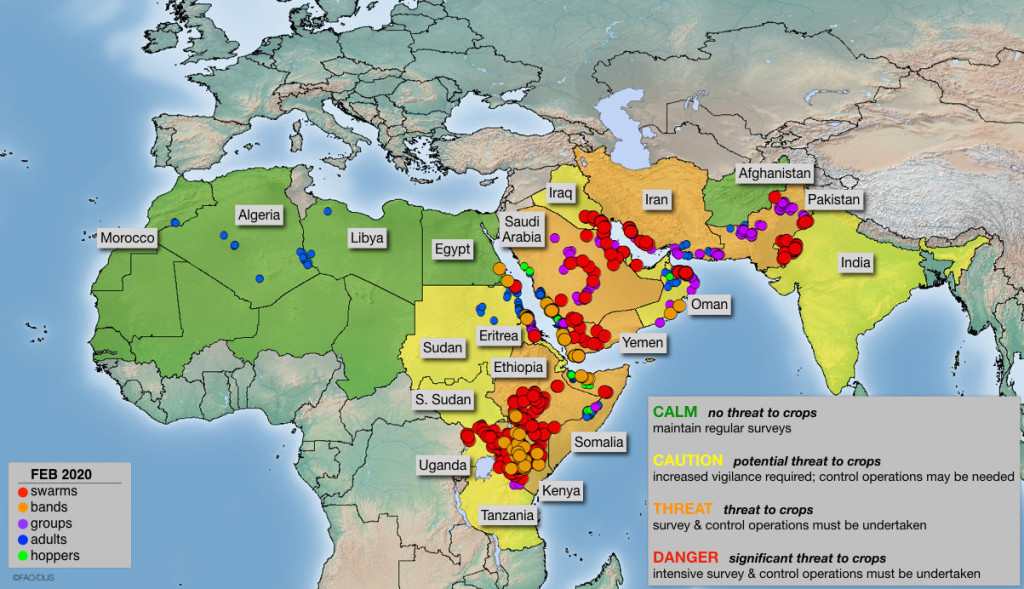Locusts in Uganda: Was the Country Prepared?
Mar 20th, 2020 | By admin | Category: Food and Hunger/AgricultureBy Joshua Mironda, youth writer for Transition Earth.
You may have heard that plagues of locusts have descended upon East Africa. This is not a biblical story, but real life, with serious implications for people and nature.Here in Uganda, at the beginning of February, desert locusts invaded the country through its Amudat district and spread to the Karamoja region in the northeast. Uganda’s government responded by sending troops to the affected areas to spray the insects before they could spread to other regions. This has been done for the past several weeks but they have not been dealt with entirely and are still a threat.
The desert locusts are believed to be the world’s most dangerous migratory pests. They can migrate long distances and have the ability to change behavior and appearance according to particular environmental conditions. They originated from Ethiopia and came through Kenya, where they left crops destroyed, caused food shortages and posed a threat to rising standards of living. It should also be noted that the affected areas were already facing food shortages even before the outbreak. According to the Food & Agriculture Organization (FAO), drought and floods are responsible for food insecurities in East Africa, affecting about 20 million people. The situation could worsen, as the desert locusts’ outbreak is considered as the most hazardous swarm in 25 years.
Some other unpleasant facts about locusts include the following:
- Locusts are found in Africa, the Middle East, and Asia and inhabit some 60 countries and can cover one-fifth of Earth’s land surface;
- Desert locust plagues may threaten the economic livelihood of one-tenth of the world’s humans;
- A desert locust swarm can be 460 square miles in size and pack between 40 and 80 million locusts into less than half a square mile;
- Each locust can eat its weight in plants each day, so a swarm of such size would eat 423 million pounds of plants every day.
Before Uganda’s locust invasion, the national government held different consultative meetings to figure out ways of cutting them off without spreading to many parts of the country. However, by early March they had spread to twenty-four districts. The Uganda government, through its Ministry of Agriculture, Animal Industry and Fisheries and Ministry of Disaster Preparedness and Refugees, resorted to using the army to fight the locusts with the help of citizens. The first attempt was the use of a rudimentary approach of foot troops but this did not go well as some locusts hang up high on trees where the pressure used couldn’t reach. They also resorted to using motor sprays that were not good enough due to fuel shortages and thus not as effective.
The government also faced criticisms from the public saying that the methods used were not efficient. Dr. Perpetra Akite from Makerere University College of Natural Sciences said, ”these locusts are always on the move and they fly as high as 200 meters.” This prompted the hire of an aircraft to aid the spraying. Some locals resorted to making them a food delicacy. But Dr. John Bahana, a consultant from the Ministry of Health, warned that while desert locusts are edible they have a hard coating, and if not prepared well can lead to constipation.
The FAO also indicated that developed locust swarms have been laying eggs within immense areas of East Africa and many are already hatching. Distressingly, within a few weeks, there will be a new generation of locusts that will transform from their youthful stage and develop wings and take off. This could devastate the number of crops in the region for the biggest part of the year.
The government has so far spent 7 billion shillings (USD 1.8 million) and more is to be invested in the fight to stop desert locusts, but is it enough? How best can these locusts be eradicated completely without endangering the environment or human health? These are still questions being asked, and Ugandans are waiting for answers.
Joshua Mirondo is a digital marketer, blogger, photographer and volunteer at Reproductive Health Uganda.

![[Photo: FAO]](http://populationgrowth.org/wp-content/uploads/2020/03/locusts-photo-300x200.jpg)
